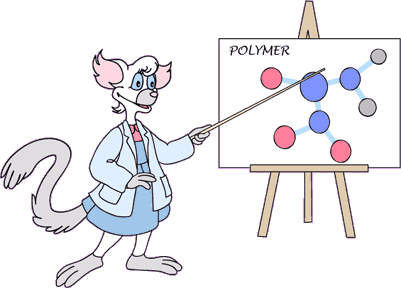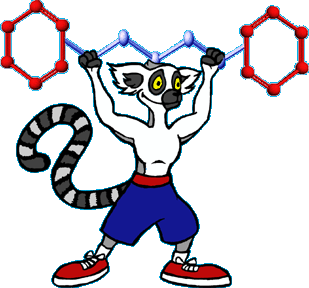
Finding Out What Polymers are Like
There are a whole bunch of different ways that we can describe polymers - what they look like, how they feel, how they smell, how they act, what they sound like when you drop them on the floor (ping! or splat!) They can be hard or soft, stiff or bendy, strong or weak, smooth or rough, shiny or dull - and lots more!
Show me the numbers
 So how can we find out just how strong a fiber is, or just how stretchy a rubber band is? And gee, why would we want to know? Well, if Leigh Murie invents a better kind of polymer fiber, how can she prove that it's really better? She'll want to use numbers, that is, she'll want to quantify just how much better her polymer is.
So how can we find out just how strong a fiber is, or just how stretchy a rubber band is? And gee, why would we want to know? Well, if Leigh Murie invents a better kind of polymer fiber, how can she prove that it's really better? She'll want to use numbers, that is, she'll want to quantify just how much better her polymer is.
She'll also want to think about - "What does better mean?" Is it stretchier, or less stretchy? Oooh, think about this one. There'd be some applications where you'd want a fiber to be stretchy and bounce back perfectly (like a bungee) but others where a lot of stretch is not good, but you want it to hold a lot of weight without breaking (like a rock-climbing rope).
Scientists have come up with all kinds of ways to test polymers to answer questions like:
How easy is it to scratch?
How much weight can a thread (or fiber, or rope) hold?
How long will it last if it's left out in the sun?
How will it act if it gets hot? Will it melt if I leave it in the car in the middle of summer?
How much heat does it take to make it all goopy?
How fast will it dissolve in your tummy? (That one is important for pill coatings.)
How well can I see through it?
What happens if I hit it with a hammer? (This one might sound funny, but polymers that can take a hit with a hammer might just be good for something like a skateboarding helmet or hockey shin pads for goalies.)
There are all kinds of instruments that scientists use to test different polymer properties. The goal is to get numbers (data) so that one polymer can be compared to another.
Understanding how to measure polymer properties isn't just for scientists. Listen closely to commercials on TV, or look at ads carefully. When companies want you to spend more money on a bike, or a toy, or a shampoo, that goes faster, lasts longer, or whatever, well, gee, how much faster, or longer, or whatever? Is it worth the extra money?
Back to polymers....
How many properties can you come up with? Try listing them out, then compare them with our list here. Hey! No peeking! Really, try to list some out first!
How Strong is Strong?

Strength, toughness, and elasticity are all mechanical properties. But what do these words really mean? How do we measure how "strong" a polymer is? What is the difference between a "strong" polymer and a "tough" polymer? The rest of this page sorts these out.
Strength
Strength is a property that you should be able to relate to, but you might not know exactly what we mean by the word "strong" when we're talking about polymers.
First, there's more than one kind of strength. The kind of strength a polymer has depends on how well the polymer holds up to whatever you're trying to do to it.
Imagine this: Take a chunk of plastic about as big and thick as your hand. Hold it by two ends, and try to pull it. If nothing happens, it's strong. But the best term to describe that kind of strength is tensile strength. Tensile strength is important for a material that is going to be stretched or under tension, like rope.
Here are some kinds of strength, starting with tensile strength. Each one depends on what you're trying to do with the sample.

|
|
And there are other kinds of strength, too!
What kind of strength would you like a bike frame to have? What about a chair cushion? Or one of your favorite toys?
What is Strength?
But what does it mean to be strong? We have a very precise definition. Let's use tensile strength as an example. To measure the tensile strength of a polymer sample, we take the sample and we try to stretch it. We usually stretch it with a special machine that simply clamps each end of the sample, then, when you turn it on, it stretches the sample. While it's stretching the sample, it measures how much force that it's exerting.
When we know the force being exerted on the sample, we then divide that number by the cross-sectional area of our sample. Why do we have to do that? Well, a thick sample would probably be harder to stretch than a thin sample. We want to get a number that would let us compare the polymer in general, not just the one sample that we happen to have.
Now, before I learned anything about polymers, I thought I knew what stress is.  Turns out that polymer people have a really specific meaning for the term stress. Stress (in this case, tensile stress) is how much force is used to stretch a sample, divided by the cross-sectional area.
Turns out that polymer people have a really specific meaning for the term stress. Stress (in this case, tensile stress) is how much force is used to stretch a sample, divided by the cross-sectional area.
You stretch a polymer, it's gonna feel the force put on it. It's gonna feel stressed.

 Then, using our machine, we keep stretching the sample, increasing the stress (the force/area) until - snap! - it breaks. How much stress could it take? The stress needed to break the sample is the tensile strength of the material.
Then, using our machine, we keep stretching the sample, increasing the stress (the force/area) until - snap! - it breaks. How much stress could it take? The stress needed to break the sample is the tensile strength of the material.
Likewise, one can imagine similar tests for compressional or flexural strength. In all cases, the strength is the stress needed to break the sample.
Toughness
How is toughness different from strength? From a physics point of view, the answer is that strength tells how much force is needed to break a sample, and toughness tells how much energy is needed to break a sample. But that doesn't really tell you what the practical differences are.
What is important is knowing that just because a material is strong, it isn't necessarily going to be tough as well. A great example is something that's rigid and brittle: it's strong, but not tough, meaning that can't stretch very far before it breaks.
Flexible plastics like polyethylene and polypropylene are different from rigid plastics in that they're easier to stretch (so their tensile strength is lower), but they tend not to break. Interestingly, the ability to stretch is what keeps them from breaking. They'll resist being stretched for a while, but if enough stress is put on a flexible plastic, it will eventually deform. You can try this at home with a piece of a plastic bag. If you try to stretch it, it will be very hard at first, but once you've stretched it far enough it will give way and stretch easily. The bottom line is that flexible plastics may not be as strong as rigid ones, but they are a lot tougher.
Going Beyond Tensile Properties
When we look at other properties, like compressional properties or flexural properties, things can be completely different. For example, fibers have very high tensile strength and good flexural strength as well, but they usually have terrible compressional strength. They also only have good tensile strength in the direction of the fibers.
Fibers have high tensile strength in only one direction.

Go to Making Polymers Stronger
References
Odian, George; Principles of Polymerization, 3rd ed., J. Wiley, New York, 1991.Jang, B. Z.; Advanced Polymer Composites: Principles and Applications, ASM International, Materials Park, OH, 1994.

|
Go to Making Polymers Stronger |

|
Return to Making Stuff |

|
Return to Main Page |